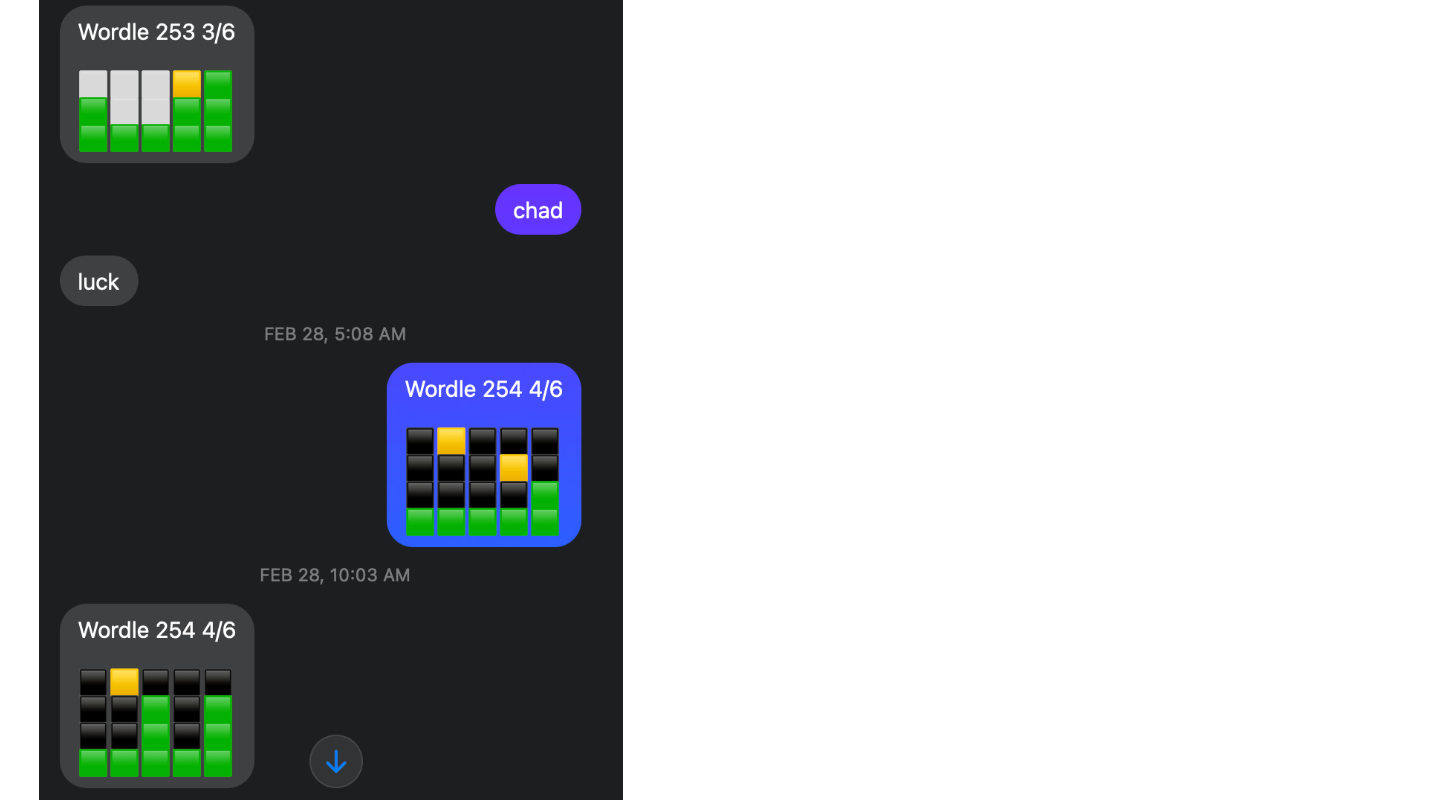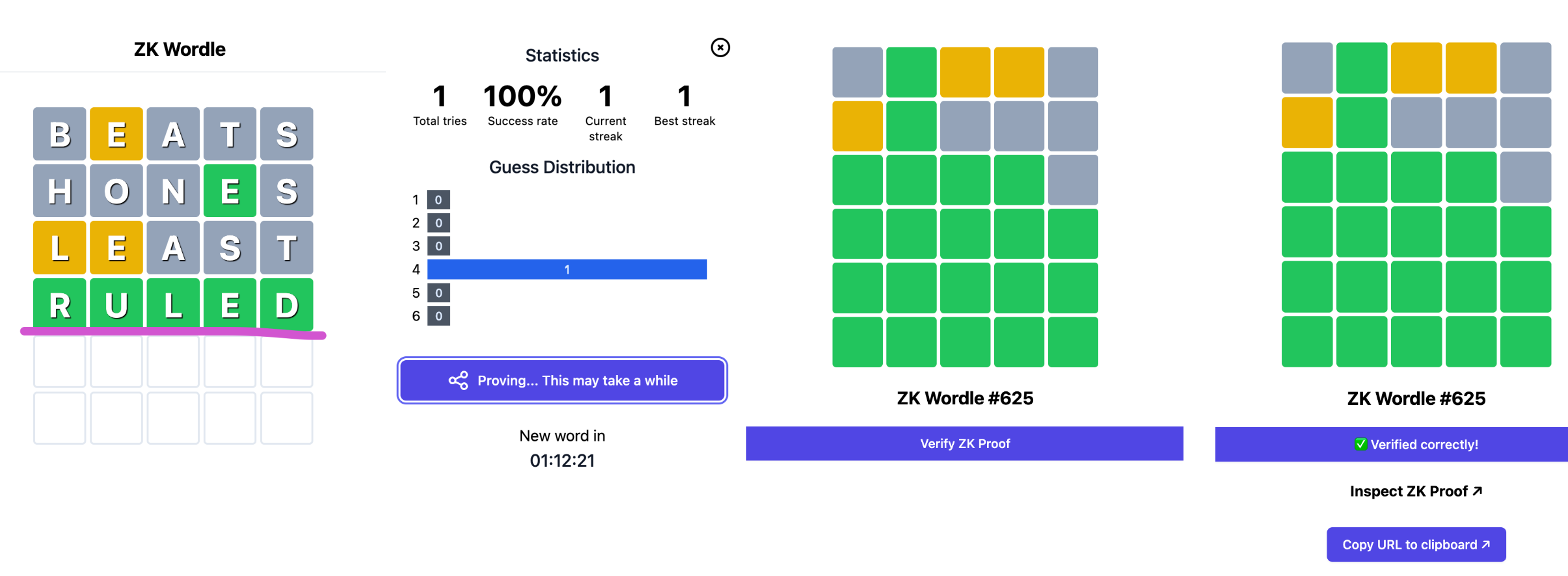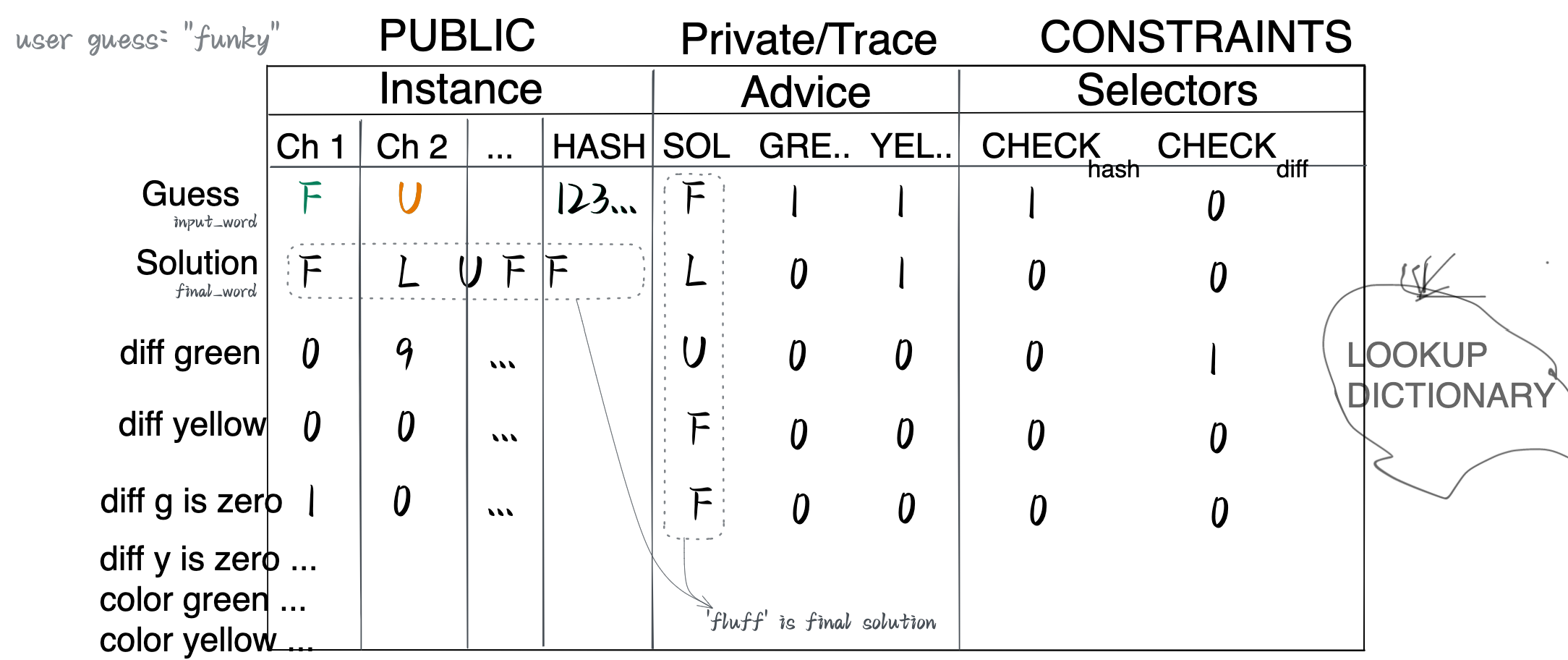Overview
Wordle:是一个猜词游戏,玩家试图猜测一个 5 个字母的单词。每当玩家猜一个单词时,游戏会告诉玩家哪些字母是正确的(用绿色表示),哪些字母在单词中但位置不对(用黄色表示),以及哪些字母不在单词中(用灰色表示)
Motivation:
在某些时候,作者与一些朋友交流他们解出的 Wordle 网格:

然而,这些表情符表格有一个致命缺陷:玩家可以在游戏结束后编辑他们的网格,让自己看起来比原来聪明得多。我总是怀疑我的朋友们是否真的得到了他们声称的分数!快使用 zk-snark!1
在 Zordle 中,在解决了当天的 Wordle 问题后,用户还会为其表格和 Guess word 生成一个 ZK Proof,证明他们知道与他们共享的一组表情符号框完全对应的一组单词!(In Zordle, after solving the day’s Wordle, a user additionally generates a ZK proof attesting that they know the set of words that perfectly correspond to a set of emoji boxes that they’re sharing!)
BUILD & user flow
- Generate Proof takes about 1 min
- Verify Proof takes about 20s
- Then user can check the proof on chain (IPFS)
- And anyone can verify it

cargo test -- --nocapture test_wordle_1
# Draw
cargo test --release --all-features print_wordle
Inspect ZK Proof:
- URL(onchain): https://ipfs.io/ipfs/QmWuSo5ivAXm8M7Mi7hPW5WHFXZ55Vjt651Cw6reL1VM9w
- When Access the URL, which is a JSON file stored on IPFS :
{
"solutionIndex":625,
"proof":[
109,177,255,176,116,185,157,128,237,146,45,233, ... ,
247,208,138,100,48,148,37,223,95,80,14,64,239,78, ... ,
// The proof is very long ,...,
105,46,209,248,49,117,197,164,130,72,157,40,33,243,21,39,..,
],
"diffs":[[[0,1,0,0,0],[0,1,1,1,0]],[[0,1,0,0,0],[1,1,0,0,0]],[[1,1,1,1,0],[1,1,1,1,0]],[[1,1,1,1,1],[1,1,1,1,1]],[[1,1,1,1,1],[1,1,1,1,1]],[[1,1,1,1,1],[1,1,1,1,1]]]}
Copy URL to clipboard ↗️ :
https://zordle.xyz/verify/QmWuSo5ivAXm8M7Mi7hPW5WHFXZ55Vjt651Cw6reL1VM9w
# 👆🏻 with this url, anyone can validate the ZKP proof to ensure that the individual possesses the correct solution, without actually knowing the answer to the Wordle.
Circuit inputs
Public inputs
- The solution word
- The grid of boxes of 6 words x 5 slots (one for each letter): each cell in the grid is either green, yellow or grey
- : the letter is in the same relative position as the letter in Solution
- : the letter is in Solution but the wrong relative position
- : wrong letter, not in the solution.
like:
1. solution word:
"fever"
2. grid of boxes of 6 words x 5 slots
🟥🟥🟨🟥🟩
🟥🟥🟩🟨🟩
🟩🟩🟩🟩🟩
🟩🟩🟩🟩🟩
🟩🟩🟩🟩🟩
🟩🟩🟩🟩🟩
Private inputs
- 6 words of 5 letters each (6 个单词,每个单词 5 个字母)
我们注意到:Wordle 的 inputs 结构使得每个 guess(猜测) 都完全独立于 others - 如果一个猜测本身有效,那么在游戏中也总是有效,反之亦然。这表明电路的一种清晰结构是:make an individual region for each guess.
对于这种每个 guess 一个 region 的构建中,让我们考虑每个 guess 需要哪些检查:
考虑 该 guess 的 grid 🟥🟥🟩🟨🟩 和 word: “lover”
- The guess 必须是一个 5 个字母的英语单词 (LOOKUP)
- 如果格子上的位置是绿色 🟩,则 guess word 相应位置的字母必须与 solution 的字母匹配
- 如果格子是黄色 🟨,类似的检查也会进行
- 如果格子不是绿色、黄色,猜测相应位置的字母不能与解答的字母匹配
lookup table Versus R1CS
通常,在 R1CS 电路中,对于存在性证明(比如 Nullifier 的 commitment),需要使用 Merkle Proof 来检查 guess word 是否为字典真实存在的单词:创建一个所有单词(12000+)的 Merkle 树,然后 witness the Merkle path of your guess in the tree。
然而,在 PLONK/Halo 2 中,可以使用查找表!虽然以这种方式使用查找表不是特别高效(因为您的电路现在将具有 12000+ 行),but it is a cool way ..
build demo
Workflow:
- generate params files like
params.bin(like verification_key / proving_key …) - use your wordle answer to generate proof.
- verify the proof you generated.
1. create a proof.bin
Firstly, we need to manually create a proof.bin file ourselves, otherwise the $ cargo run command will report an error.
cd circuits
touch proof.bin
2. generate public params
$ cargo test -- --nocapture test_wordle_1
$ cargo run
write # take ~3 min to generate `params.bin` and `diffs_json.bin`,
# Welcome to zk wordle!
# Enter play to play the game, verify to check a proof, or write to generate a new # # params file
# write
3. gen proof (if guessed)
$ cargo run
play # correct input : fluff
Welcome to zk wordle!
Enter play to play the game, verify to check a proof, or write to generate a new params file
play
Enter a word:
proof
🟥🟥🟥🟥🟩
Enter a word:
leave
🟨🟥🟥🟥🟥
Enter a word:
belif
🟥🟥🟨🟥🟩
Enter a word:
Foulf
🟥🟥🟩🟨🟩
// ... many rounds...
Enter a word:
fluff
🟩🟩🟩🟩🟩
You win! Generating ZK proof...
Successfully generated witness
Successfully generated proving key
Successfully wrote proof to proof.bin
Verifying proof for final word fluff
Share Sheet:
🟩🟩🟩🟩🟩
🟩🟩🟩🟩🟩
🟩🟩🟩🟩🟩
🟩🟩🟩🟩🟩
🟩🟩🟩🟩🟩
🟩🟩🟩🟩🟩
Proof OK!
# or You lose! and exit.
verify proof
Then we acn verify
# verification takes about 15s, 1GB Memory
Welcome to zk wordle!
Enter play to play the game, verify to check a proof, or write to generate a new params file
verify
Verifying proof for final word fluff
Share Sheet:
🟩🟩🟩🟩🟩
🟩🟩🟩🟩🟩
🟩🟩🟩🟩🟩
🟩🟩🟩🟩🟩
🟩🟩🟩🟩🟩
🟩🟩🟩🟩🟩
Proof OK!
在我找到了正确答案并生成 proof 的过程中,如果我强制退出 generate_proof 程序,在验证时:
verify
Verifying proof for final word fluff
Share Sheet:
🟥🟩🟩🟥🟥
🟩🟩🟩🟩🟩
🟩🟩🟩🟩🟩
🟩🟩🟩🟩🟩
🟩🟩🟩🟩🟩
🟩🟩🟩🟩🟩
Proof not OK!
会出现奇怪的 sheet,且 verification 不通过,原因不明
wasm
【EDITING】
files directory & Code explanation
$ tree show the code structure :
#![allow(unused)] fn main() { ├── lib.rs ├── main.rs // play(gen prove-prove_play) verify write_params ├── wasm.rs ├── wordle │ ├── wordle │ │ ├── dict.json // 12972 个英文单词, 如 “white” │ │ ├── dict.rs // [738547, 742032, ..., 760311, 760617, 760805 .. │ │ ├── is_zero.rs // IsZeroChip │ │ ├── table.rs // Lookup table, 将 12972 个 5 字母 word 放入查找表 │ │ └── utils.rs // word_to_chars, compute_diff.. │ └── wordle.rs └── wordle.rs // pub mod wordle; }
Lookup table - table.rs
lol perhaps best thought LOOKUP table of as a giant fixed set(constant set) instead of a circuit table column.
作用: 将 12972 个 5-letter words 加载到 LOOKUP 查找表里。
这些 words 的形式类似:
vec![738547, 742032, ... , 760311, 760617, 760805,...
#![allow(unused)] fn main() { #[derive(Serialize, Deserialize)] struct Dict { words: Vec<String>, } impl<F: PrimeField> DictTableConfig<F> { pub(super) fn load(&self, layouter: &mut impl Layouter<F>) -> Result<(), Error> { // 12972 个 5-letter words, like [783431, 2149761, 11454874].. let mut words = get_dict(); words.push(0); layouter.assign_table( || "load dictionary-check table", |mut table| { let mut offset = 0; for word in words.iter() { table.assign_cell( || "num_bits", self.value, offset, || Value::known(F::from(word.clone() as u64)), )?; offset += 1; } }
dict
wordle/wordle/dict.rs :
#![allow(unused)] fn main() { pub fn get_dict() -> Vec<u32> { vec![738547, 742032, 747019, 747397, 756988, 756996, 756998, 757006, 757094, 757220, 757293, 757310, 757456, 757459, 757462, 757485, 757626, 757789, 757890, 757905, 757911, 758196, 758732, 760306, 760311, 760617, 760805, 760863, 763240, 763749, 763792, 766300, 766314, 766315, 766316, 766609, 767239, ........ }
wordle/wordle/dict.json : ``
#![allow(unused)] fn main() { {"words": [ "aahed", "aalii", "aargh", "aarti", // .... // .... // .... } }
wordle.rs
#![allow(unused)] fn main() { #[derive(Debug, Clone)] /// A range-constrained value in the circuit produced by the RangeCheckConfig. struct RangeConstrained<F: PrimeField>(AssignedCell<Assigned<F>, F>); }
Constraints (custom gate)

如上图,在 Custom gate 编写电路约束时,会为每一个 Guess word 在 region 里分配如上图这样一个布局。
- 本轮 Guess word 是 $\textcolor{green}{f}\textcolor{orange}{u}nky$
- Solution(final_word) 是 $fluff$
- 电路会去计算 & 约束各种配置 …
assign to region
#![allow(unused)] fn main() { /// ...... // make an individual region for each guess. for i in 0..WORD_LEN { // guess word, provided by the user. place on the row-0 region.assign_advice(|| "input word characters", self.chars[i], 0, || chars[i])?; // solution word, provided by the user. place on the row-1 region.assign_advice_from_instance(|| "final word characters", self.final_word_chars_instance, i, self.chars[i], 1)?; // diff_green: if guess[i] matches solution[i], then diff_green is 0, Otherwise is the distance between 2 chars region.assign_advice(|| "diff_green", self.chars[i], 2, || diffs_green[i])?; // diff_yellow: if guess[i] ∈ solution, then diff_yellow is 0, Otherwise is the distance multiplication region.assign_advice(|| "diff_yellow", self.chars[i], 3, || diffs_yellow[i])?; /// ...... }
Circuit
#![allow(unused)] fn main() { pub struct WordleCircuit<F: PrimeField> { pub poly_words: [Value<Assigned<F>>; WORD_COUNT], pub word_chars: [[Value<Assigned<F>>; WORD_LEN]; WORD_COUNT], pub word_diffs_green: [[Value<F>; WORD_LEN]; WORD_COUNT], pub word_diffs_yellow: [[Value<F>; WORD_LEN]; WORD_COUNT], } impl<F: PrimeField> Circuit<F> for WordleCircuit<F>{ fn without_witnesses(&self) -> Self { .. } fn configure(meta: &mut ConstraintSystem<F>) -> Self::Config { .. } fn synthesize( &self, config: Self::Config, mut layouter: impl Layouter<F>, ) -> Result<(), Error> { config.table.load(&mut layouter)?; for idx in 0..WORD_COUNT { // println!("idx {:?} diffs_green: {:?}", idx, self.word_diffs_green[idx]); config.assign_word( layouter.namespace(|| format!("word {}", idx)), self.poly_words[idx], self.word_chars[idx], self.word_diffs_green[idx], self.word_diffs_yellow[idx], idx, )?; } Ok(()) } }
illustration
Circuit :
QA:
Why Rotation(-2)?就具体在这个 wordle 电路里面,你试着理解和推理下,为什么要使用 Rotation(-2)
在给出的 WordCheckConfig 电路配置中,Rotation(-2) 被用于几个地方。这些用途都与字符差异和颜色判断有关。让我们深入挖掘并理解它的具体用途。
- 字符差异检查:
当比较Wordle中的字符以确定绿色和黄色的匹配时,我们通常会查看所猜测的单词与实际的目标单词之间的字符差异。Rotation(-2)似乎被用于访问电路中早期的某个位置,该位置可能包含前一个单词或猜测的单词。
let char = meta.query_advice(chars[i], Rotation(-2));
- 颜色为零检查:
代码中的Rotation(-2)也被用于与颜色检查相关的部分。在Wordle中,字符可能是绿色、黄色或灰色。灰色表示字符不在目标单词中。绿色表示字符位置正确,而黄色表示字符存在但位置不对。Rotation(-2)可能被用来查询前一个猜测中的字符颜色或与之相关的其他信息。
let diff_color_is_zero = meta.query_advice(chars[i], Rotation(-2));
通过这两点,我们可以推测为什么使用 Rotation(-2):
电路的每一行可能代表一个字符位置的不同状态或检查。在检查猜测与实际单词之间的匹配时,电路需要对照早先的行(可能是前一个猜测或前两个状态)。这就是为什么需要查询 Rotation(-2):它代表与当前字符或状态相对的早先的状态或检查。
具体地,这里的 Rotation(-2) 可能表示查询与当前字符位置前两个位置或状态相关的数据,这有助于确定字符的正确性、颜色或其他属性。
References
Ignore the minor technical detail that they can always just cheat by looking up the day’s word elsewhere. 😅